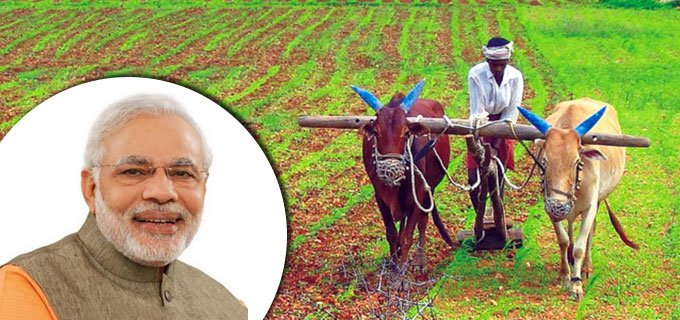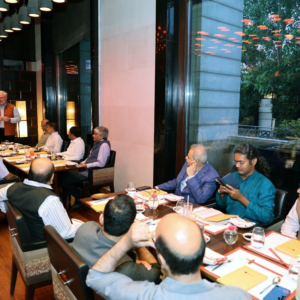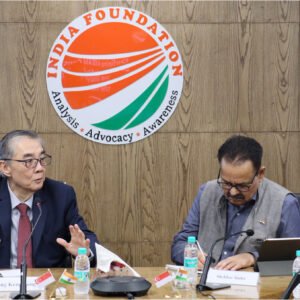India is the largest producer of milk, jute and pulse in the world, second largest in sugarcane, cotton, groundnut, fruits, vegetables and fisheries production and third in cereal production.[i] Despite this, the agricultural growth rate is dismally low and Indian farmers are for the most part, poverty stricken. We need pragmatic answers to the woes of the farmers, if we have to raise the standard of living of the majority of out people. As per an U.N report, 21% of people in India live below the poverty line. Over 30% even have less than $1.25 per day available – they are considered extremely poor. This makes the Indian subcontinent one of the poorest countries in the world; women and children, the weakest members of Indian society, suffer most even in the 21st century.
If the situation is to be improved, then reforms in the agriculture sector, which employs 41.49 percent of India’s workforce[ii] is an imperative. More importantly, about 70 percent of its rural households still depend primarily on agriculture for their livelihood.[iii] Talking of agricultural reforms in India is like having the aspirations for a bullet train track in Ranchi or Patna. It seems an impossible project because of diverse and dissenting views. But answers must be found. Reforms of course are not a panacea to all the ills of the farm sector, but it is a vital and important step towards improving the lives of the vast number of people engaged in farming.
Why Reforms are Needed
There are a plethora of issues which needs to be addressed: rotting of tonnes of surplus food grains in government godowns, denial of proper prices for their produce to the farmers, poor irrigation infrastructure, fluctuations of climatic conditions and the policy of the government to support Agriculture till date with loan waivers and announcement of M.S.P. (Minimum Support Price). There are varied reasons of farmer’s distress.
India is basically an agrarian economy and the agricultural sector needs reforms, if we have to raise the standard of living of the majority of our people. The Farms Bills, passed by the government are a step in this direction. They have the potential to change the face of Indian agriculture by transforming agriculture, the main means of livelihood of a vast majority of people, into an agri-business enterprise. This will provide to the burgeoning population, new avenues of economic opportunities and propel a revolution agriculture, much like the Green revolution of 1966. When the ‘Kesar’ of Kashmir, ‘Makhana’ of Bihar, ‘Mango and Guavas’ of Uttar Pradesh, ‘Bamboo shoots’ of North-East, ‘Bhindi’ of Gujarat and ‘Kathal and Prawns’ of Orissa get a global market platform, India’s hard-working farmers will get the right price for their produce, free from interference by intermediaries or middlemen. The vision of Prime Minister Modi is to transform India into a food-export powerhouse, exploring local possibilities and marketing them globally.
Gandhiji once said: ‘Real India lives in the villages… the India of my dreams will be one where agriculture would bring economic self-sufficiency’. But post-Independence, the experiment with democracy has also witnessed bad experiments in the economic sector leading to lop-sided growth, increasing poverty and unemployment due to neglect of the agricultural sector. Most of the Governments brought changes and reforms but lacked a vision and foresight. Except for the Green Revolution of 1966, most of the time the agricultural sector suffered because of the liberalisation and privatisation model being imbibed across the world.
Mahatma Gandhi National Rural Employment Guarantee Act (MRNREGS) and Public Distribution System have generally been used as doles to certify the path of welfare state followed by India, but till date has not achieved the desired results. Now, in a bid to transform the agriculture sector, the Modi led NDA Government has brought three prominent Agricultural reforms which have the potential to revamp and overhaul the stagnant agricultural sector.
The Farm Laws
The three Farm Reform Laws brought by the government are:
- Farmers’ Produce Trade and Commerce (Promotion and Facilitation) Act, 2020
- Farmer’s (Empowerment and Protection) agreement on price assurance and Farmservices Act, 2020
- Essential Commodities (Amendment) Act, 2020
These three reform bills have the capacity to lay down the roadmap for agricultural self-sufficiency and prosperity in India. They take into account various research studies and reports of public policy over the last fifty years by various governments, and hence, no political motive can be ascribed to the passage of these bills. Their impact on the agriculture sector and on the income of the farmers is likely to be far-reaching, if backed by proper regulatory and institutional mechanisms to ensure fairness and transparency.
The reforms shall be beneficial to small farmers as it lays down the procedure for barrier-free inter-state and intra-state trade of farmer’s produce. This first Bill aims to end the license-permit raj in the agricultural sector, which benefitted the middleman at the cost of the farmer. The farmers can also explore the possibility of selling their produce online. The second Bill ushers in the system of contract farming in India. Farmers can now enter into long-term contracts (upto five years) with agri-business firms for selling their future produces at a pre-agreed price, assuring them future income despite fluctuations of weather. For the farmer, there is no transportation and storage costs and they end up with a better price for their goods. Further, there shall be no change in Minimum Support Prices and no loss to agricultural mandis. Amendments have also been made in the Essential Commodities Act for better price realisation to farmers. Agricultural products like cereals, edible oils, oilseeds, pulses, onions, potatoes shall be deregulated. New funds for fisheries, dairy development, herbal plantation, livestock vaccination shall be created.
Opposition to agricultural market reforms is politically motivated, and designed to preserve the standing of certain vested interests. While the country was still struggling with the Chinese virus which caused the Covid-19 pandemic, the decision of the farmers to hit the streets had far-reaching political ramifications. Farmers from Punjab, Haryana, Rajasthan and Western Uttar Pradesh became the major force behind the protests. In Punjab, Congress along with Akali Dal— a long time ally of the BJP in NDA, also supported the farmer’s protest. Ms Harsimrat Kaur Badal, a minister in the NDA government, quit the cabinet due to differences of opinion on the issue. Captain Amarinder Singh, the chief minister of Punjab passed laws in the State Assembly to nullify the Central Farm laws. The other Congress-ruled State governments in Rajasthan, and Chattisgarh also passed similar legislations. Several rounds of negotiations between the farmer’s union and Govt. representatives did not bear any fruit. As a result, a stalemate was created on the farm reforms and the matter is now sub-judice.
A History of Protests
Even earlier, the nullification of Article 370, legislation of C.A.A and its supposed connection with NRC, NPR, CAB was a new campaign promulgated by the ‘Left Liberals’ which in course of time turned into a violent agitation. For much of the 20th century, the process of ‘Constitutionalism’ in India had been governed by the ideology of the ‘Liberal Socialists’ who aimed at the reconstruction of the society but could never achieve it. When the electorates preferred market and free choice, the ‘Liberals’ expressed ‘powerlessness’ in the new system and favoured economic redistribution through the affirmative action model, but paradoxically, none could achieve the desired results. Hence, the new campaign of the leftist elites is to misguide and disillusion the farmers and peasants against any constructive reform by the government.
Recently, the tractor rally and violent protests at Red Fort, which was predominantly led by the intermediaries and supported by some opposition parties against laws made by a government which enjoys a comfortable majority in Parliament was indicative of a reign of terror and anarchism sponsored by vicious cartels and opposition groups. Noise and violence had become the currency of discourse in the largest democracy of the world for some time.
The performance data of procurement of food-grains under the M.S.P by the Food Corporation of India is an eye-opener and story-teller in this direction. In the past 15 years (2003-2017), procurement by government agencies has been 26.8 percent for wheat (procurement of 359 million tonnes versus production of 1,340 million tonnes) and 31.3 percent for rice (procurement of 488 million tonnes, production of 1,558 million tonnes). The numbers are similar for 2018–31.3 percent procurement of wheat, 32.7 percent for rice. The question to be asked then is, where does the balance go?
According to the Sixty-Second Report of the Standing Committee on Agriculture (2018-2019) titled, ‘Agriculture Marketing and Role of Weekly Gramin Haats’, presented to Parliament in January 2019, the surplus is purchased by moneylenders and traders at very low prices. The moneylender and traders buy independently or work as an agent of a bigger merchant of the nearby mandi. Clearly, the balance of power is against small farmers.[iv] The small and marginal farmers constitute 86% of our agricultural class. This vulnerable class becomes the victim of money-lenders and intermediaries in the absence of government procurement and low prices. As a result, the middleman and intermediaries have their discretion to fix throwaway and low prices for the crop.
Today, the drivers of the Farm reforms protest are these rich and influential farmers and middlemen. Thus, ‘the politics of the past is attempting to prevent the prosperity of the future.’[v] Which is why, the intention of the Narendra Modi government to transform the agricultural sector into a modern business enterprise by linking the crop yields of the farmers with the global market is a landmark decision. It shall directly improve the lives of lakhs of farmers who shall get a better price for their crops. Hence, all the protests and demonstrations sponsored by middlemen and intermediaries are directed to stall the reform process which will lead to a loss of thousands of crores for them.
Notwithstanding the noisy public discourse, the agricultural sector under Modi government has been steadily improving and will witness a fillip with latest farm reforms, contrary to the opposition by some quarters. The resilience of the farming community in the face of adversities and economic recession has made agriculture the only sector to have recorded a positive growth of 3.4% at constant prices in 2020-21, when other sectors were declining. Either it is because of the Lockdown and Reverse Migration of labour, or the slowdown in industrial growth, agriculture has emerged as a saviour in this time of distress. The share of agriculture in Gross Domestic Product has reached almost 20% for the first time in the last 17 years, making it the sole bright spot in G.D.P performance during 2020-21. During 2020-21, while the Gross Value added for the entire economy contracted by 7.2%, growth in Gross Value Added for agriculture maintained a positive growth of 3.4%.
Union Agriculture Minister Giriraj Singh, during an interaction with the media highlighted the fact that while wheat worth Rs 33,000 crore was procured during 2013-14, which increased to Rs 62,000 crore during 2019-20, with a growth of 87%. Similarly, paddy worth Rs 63,298 crore was procured between 2013-14 which went up to Rs 1.41 lakh crore in 2019-20. Further, 106 lakh farmers in the country have benefitted through the Direct Bank Transfer (DBT) scheme of Rs 6000 each.[vi] He also highlighted the fact that the budget allocation for agriculture was Rs 88,811 crore between 2009 and 2014, which has increased to Rs 4,87,238 crore between 2014 and 2020, registering a growth of 438%. The agricultural credit during 2013-14 was Rs seven lakh crore, which has gone upto Rs 16.5 lakh crore during the financial year 2021-22—an increase of 135%.
Hence, a closer introspection of the statistics reveals the fact that the regulatory policies in the agricultural sector is leading to the welfare of the farmers due to a quantum jump in the crop yield and thereby consolidating the creditability of agriculture reforms in the long run.
Recommendations
In the words of Amit Kalantri, ‘A farmer is a magician who produces money from the mud.’ Hence, certain things need to be kept in mind while unveiling the Farm reforms in future.First, the focus of agricultural policies must shift from production per se to farmers’ livelihoods. Hence, such crop yields should be encouraged which help in creating sustainable livelihood opportunities in the long run and encourage agricultural crop diversity. Secondly, the local administration should assist new start-ups and provide all possible protection from anti-social elements. Thirdly, climate fluctuations create high risk for the quality and output of yield. Hence, soil health and climatic factors should be taken into consideration.Fourthly, it is important that the farmers are given education, training and expertise in mechanised farming in the crops of their farm . Fifthly, a low Minimum Support Price for various farm produces fails to cover the cost incurred and thereby creates agrarian distress, farmer indebtedness and suicides. The govt. shall have to do a tight-rope walk on this front as raising the M.S.P shall invite the ire of W.T.O and also create inflationary conditions. Hence, in course of time, an alternative to the Minimum Support Price should be evolved so that the farmers get maximum benefit of their produce in the market.
Conclusion
Agriculture remains the world’s biggest employer. It is the most important source of food and raw materials for various economic activities and the only source of sustenance for 70 percent of India’s population. The Government must push ahead with the farm reforms in the interest of farmers, despite the opposition by vested interests. Regulating the implementation of farm laws is also important for the future of the B.J.P government as the implementation and transition of the agrarian economy will have a positive impact on the outcome of 2024 Lok Sabha elections.
The Narendra Modi government has laid down pathbreaking achievements and the governance style of the Prime Minister has helped solve many complex issues: Terrorism in Kashmir through abrogation of Article 370, construction of Ram temple in Ayodhya, rise of India as a Soft power on the Foreign policy front, abolishing instant Triple Talaq, and the establishment of good governance models in various states. The Farm Reforms 2020 are also a gigantic step in the right direction as they will definitely help in new job creation and agricultural prosperity. The fulfilment of a number of Sustainable Development Goals is also anchored on the performance of this sector.The SDGs are interconnected in many contexts and a link with agriculture is clear for many of them as explained in the Table below. (See Table 1)
Table 1: Agriculture’s link with SDGs [vii]
| SDG | Link with Agriculture |
| SDG 1: End poverty in all its forms. Everywhere | As most of the poor in the developing world are dependent on agriculture, ending poverty is linked to increasing returns from agriculture. Major indicators are ownership and control over land and natural resources, both of which are essential endowments for practicing agriculture. |
| SDG2: End hunger, achieve food security and improved nutrition and promote sustainable agriculture | Directly related to sustainable agriculture |
| SDG3: Ensure healthy lives and promote well-being for all at all ages | Can only be achieved through nutritious food produced via agriculture and allied sectors |
| SDG5: Achieve Gender Equality and empower all women and girls | Women play an important but largely unrecognised role in agriculture; their empowerment, decision-making and time for care work are pathways in leveraging agriculture for nutrition |
| SDG 6: Ensure availability and sustainable management of water and sanitation for all | Increasing water use efficiency across sectors, integrated water resource management, and protection and restoration of water related ecosystems—all have a bearing on agriculture |
| SDG7: Ensure access to affordable, reliable, sustainable and modern energy for all | Reduction in agriculture’s dependence on fossil fuels and consequent pollution |
| SDG8: Promote sustained, inclusive and sustainable economic growth, full and productive employment and decent work for all | Agriculture engages a large segment of the working population and consequently has a bearing on the realisation of decent work and economic growth |
| SDG10: Reduce inequality within and among countries | Disparity in asset ownership and wages in agriculture activities |
| SDG12: Ensure sustainable consumption and production patterns | Sustainable management of all natural resources, sustainable production patterns, and reducing food loss and waste |
| SDG13: Take urgent action to combat climate change and its impacts | Strengthening resilience and adaptive capacity of agriculture to the impacts of climate change, and lowering green-house gas emissions without affecting food production |
| SDG 14: Conserve and sustainably use the oceans, seas and marine resources for sustainable development. | Conservation and sustainable use of marine and coastal ecosystems, reduction of pollution, and sustainable fish harvest. |
| SDG 15: Protect, restore and promote sustainable use of terrestrial ecosystems, sustainably manage forests, combat desertification, and halt and reverse land degradation and halt biodiversity loss | All these are the feedstock for agriculture activities; indiscriminate agriculture expansion has led to decline of forest area and biodiversity loss and overexploitation of land, resulting in degradation. |
(Author Brief Bio: Saumya Maniny Sinha teaches Political Science at St. Xavier’s College, Ranchi, Jharkhand.)
[i] Address of Finance Minister, Nirmala Sitharaman to the media in June, 2020.
[ii] https://www.statista.com/statistics/271320/distribution-of-the-workforce-across-economic-sectors-in-india/
[iii] http://www.fao.org/india/fao-in-india/india-at-a-glance/en/
[iv] Chikermane , Gautam, ‘ Agriculture reforms: ignore political rhetoric, embrace prosperity economics,’ Sep 22,2020
[v] ibid
[vi] Modi govt allocated 438% more budget to agriculture sector compared to UPA: Giriraj Singh, The Times of India
PTI | Updated: Feb 6, 2021, 13:59 IST accessed on 18th April, 2021.
[vii] R V Bhavani in RV Bhavani and Priya Rampal, “Harnessing Agriculture for Achieving the SDGs on Poverty and Zero Hunger,” ORF Issue Brief No. 407, October 2020, Observer Research Foundation.




